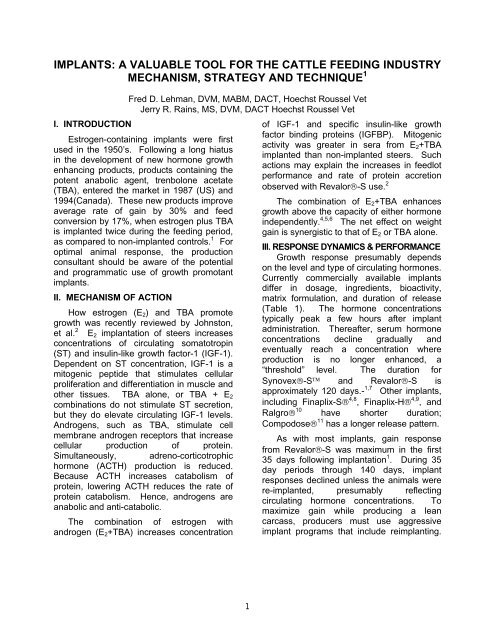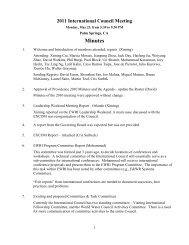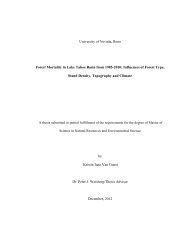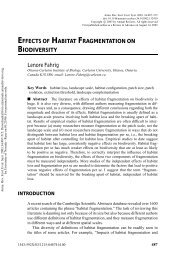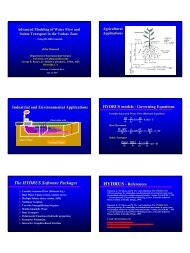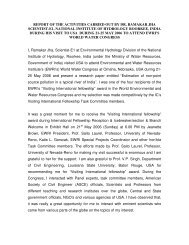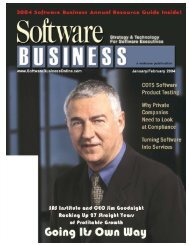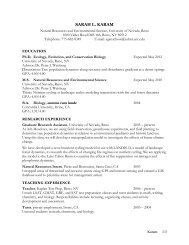IMPLANTS: A VALUABLE TOOL FOR THE CATTLE FEEDING ...
IMPLANTS: A VALUABLE TOOL FOR THE CATTLE FEEDING ...
IMPLANTS: A VALUABLE TOOL FOR THE CATTLE FEEDING ...
You also want an ePaper? Increase the reach of your titles
YUMPU automatically turns print PDFs into web optimized ePapers that Google loves.
<strong>IMPLANTS</strong>: A <strong>VALUABLE</strong> <strong>TOOL</strong> <strong>FOR</strong> <strong>THE</strong> <strong>CATTLE</strong> <strong>FEEDING</strong> INDUSTRY<br />
MECHANISM, STRATEGY AND TECHNIQUE 1<br />
I. INTRODUCTION<br />
Fred D. Lehman, DVM, MABM, DACT, Hoechst Roussel Vet<br />
Jerry R. Rains, MS, DVM, DACT Hoechst Roussel Vet<br />
Estrogen-containing implants were first<br />
used in the 1950’s. Following a long hiatus<br />
in the development of new hormone growth<br />
enhancing products, products containing the<br />
potent anabolic agent, trenbolone acetate<br />
(TBA), entered the market in 1987 (US) and<br />
1994(Canada). These new products improve<br />
average rate of gain by 30% and feed<br />
conversion by 17%, when estrogen plus TBA<br />
is implanted twice during the feeding period,<br />
as compared to non-implanted controls. 1 For<br />
optimal animal response, the production<br />
consultant should be aware of the potential<br />
and programmatic use of growth promotant<br />
implants.<br />
II. MECHANISM OF ACTION<br />
How estrogen (E 2 ) and TBA promote<br />
growth was recently reviewed by Johnston,<br />
et al. 2 E 2 implantation of steers increases<br />
concentrations of circulating somatotropin<br />
(ST) and insulin-like growth factor-1 (IGF-1).<br />
Dependent on ST concentration, IGF-1 is a<br />
mitogenic peptide that stimulates cellular<br />
proliferation and differentiation in muscle and<br />
other tissues. TBA alone, or TBA + E 2<br />
combinations do not stimulate ST secretion,<br />
but they do elevate circulating IGF-1 levels.<br />
Androgens, such as TBA, stimulate cell<br />
membrane androgen receptors that increase<br />
cellular production of protein.<br />
Simultaneously, adreno-corticotrophic<br />
hormone (ACTH) production is reduced.<br />
Because ACTH increases catabolism of<br />
protein, lowering ACTH reduces the rate of<br />
protein catabolism. Hence, androgens are<br />
anabolic and anti-catabolic.<br />
The combination of estrogen with<br />
androgen (E 2 +TBA) increases concentration<br />
of IGF-1 and specific insulin-like growth<br />
factor binding proteins (IGFBP). Mitogenic<br />
activity was greater in sera from E 2 +TBA<br />
implanted than non-implanted steers. Such<br />
actions may explain the increases in feedlot<br />
performance and rate of protein accretion<br />
observed with Revalor®-S use. 2<br />
The combination of E 2 +TBA enhances<br />
growth above the capacity of either hormone<br />
independently. 4,5,6 The net effect on weight<br />
gain is synergistic to that of E 2 or TBA alone.<br />
III. RESPONSE DYNAMICS & PER<strong>FOR</strong>MANCE<br />
Growth response presumably depends<br />
on the level and type of circulating hormones.<br />
Currently commercially available implants<br />
differ in dosage, ingredients, bioactivity,<br />
matrix formulation, and duration of release<br />
(Table 1). The hormone concentrations<br />
typically peak a few hours after implant<br />
administration. Thereafter, serum hormone<br />
concentrations decline gradually and<br />
eventually reach a concentration where<br />
production is no longer enhanced, a<br />
“threshold” level. The duration for<br />
Synovex®-S and Revalor®-S is<br />
approximately 120 days.- 1,7 Other implants,<br />
including Finaplix-S® 4,8 , Finaplix-H® 4,9 , and<br />
Ralgro® 10 have shorter duration;<br />
Compodose® 11 has a longer release pattern.<br />
As with most implants, gain response<br />
from Revalor®-S was maximum in the first<br />
35 days following implantation 1 . During 35<br />
day periods through 140 days, implant<br />
responses declined unless the animals were<br />
re-implanted, presumably reflecting<br />
circulating hormone concentrations. To<br />
maximize gain while producing a lean<br />
carcass, producers must use aggressive<br />
implant programs that include reimplanting.<br />
1
Table 1.<br />
Implant<br />
Implants: Approvals, Growth Promotant, & Release Time<br />
Approval: Animal<br />
And hormone (mg)<br />
Estrogenic<br />
Effect (mg)<br />
Androgenic<br />
Effect (mg)<br />
Anabolic<br />
Effect<br />
(Days)<br />
Original or<br />
Generic<br />
Synovex-C<br />
Calves 400 lbs<br />
14.4 0 120 Original<br />
20 estradiol benzoate/<br />
200 testosterone<br />
Synovex-H<br />
Heifers >400 lbs<br />
14.4 200 T-4 120 Original<br />
20 estradiol benzoate/<br />
200 testosterone<br />
Implus-H<br />
Heifers >400 lbs<br />
14.4 200 T-4 120 Generic<br />
20 estradiol benzoate/<br />
200 testosterone<br />
Component E-H<br />
Heifers >400 lbs<br />
14.4 200 T-4 Unknown Generic<br />
20 estradiol benzoate/<br />
200 testosterone<br />
Revalor-G<br />
Pasture Steers & Heifers<br />
8 40 TBA 120 Original<br />
8 estradiol 17 beta/<br />
40 TBA<br />
Ralgro Magnum Steers in confinement<br />
22-26 0 Unknown Original<br />
72 Zeranol<br />
Compudose 200<br />
All Classes<br />
24 0 168 Original<br />
24 estradiol 17 beta<br />
Compudose 400<br />
All Classes<br />
48 0 336 Original<br />
48 estradiol 17 beta<br />
Finaplix-S Confinement Steers 140 TBA 0 140 TBA 105 Original<br />
Component T-S Confinement Steers 140 TBA 0 140 TBA Unknown Generic<br />
Finaplix-H Confinement Heifers 200 TBA 0 200 TBA 105 Original<br />
Component T-H Confinement Heifers 200 TBA 0 200 TBA Unknown Generic<br />
Synovex-Plus Confinement Steers 28<br />
estradiol benzoate/200 TBA<br />
Revalor-S<br />
Confinement Steers<br />
24 estradiol 17beta/120 TBA<br />
Component TE-<br />
Confinement Steers<br />
S<br />
24 estradiol 17beta/120 TBA<br />
Revalor-H<br />
Confinement Heifers<br />
14 estradiol 17beta/140 TBA<br />
20 200 TBA 120 Original<br />
24 120 TBA 120 Original<br />
24 120 TBA Unknown Generic<br />
14 140 TBA 120 Original<br />
NOTE:<br />
1) estradiol benzoate = 72% estradiol-17B when computing estrogenic effect<br />
2) T-4 = Testosterone and TBA = Trenbolone Acetate: 1 mg. TBA has 8-10X growth promotion effect compared to 1 mg<br />
testosterone<br />
Ralgro ® and Ralgro Magnum ® : product of Schering-Plough<br />
Compudose ® : product of Elanco, marketed by Vet Life<br />
Synovex ® -S, Synovex ® -H, Synovex ® -C: products of Fort Dodge Labs.<br />
Implus ® -S, Implus ® -H, Calf-oid ® : products of Ivy Labs., marketed by Pharmacia Upjohn<br />
Component ® E-C, Component ® E-H, Component ® E-S, Component ® TE-S, products of Ivy Labs., marketed by Vet Life<br />
Revalor ® -G, Revalor ® -S, Revalor ® -H, Finaplix ® -H, Finaplix ® -S: products of Hoechst Roussel Vet<br />
2
However, to maximize fat deposition and<br />
marbling, more conservative strategies are<br />
useful. 13<br />
If implants act through hormone<br />
concentrations, higher dose levels should<br />
provide higher rates of gain. One dose of<br />
24mg of estradiol-17B plus 120 mg. of TBA<br />
(Revalor®-S) improved performance by 3%<br />
when compared to two doses of 20 mg<br />
Estradiol-benzoate (Synovex-S®) reimplanted<br />
during a 140 day feeding period (Table 2).<br />
Two doses of Revalor®-S improved<br />
performance by nearly 10% over the two<br />
doses of 20 mg. Of estradiol-benzoate in the<br />
same time period. 14 Responses observed in<br />
Canadian trials were 1.1 – 2.6% numerical<br />
increase for a single dose of Revalor®-S,<br />
versus two doses of Synovex®-S (reimplant)<br />
in 121-149 day feeding periods,<br />
respectively. 15<br />
However, more is not always better. 16<br />
Administration of multiple implants within a<br />
short interval (“stacking”) or excess estrogen<br />
or androgen can have adverse effects,<br />
perhaps via down-regulation of the<br />
hypothalamus and (/or) occupation of<br />
estrogen receptor sites. 17 Implanting too<br />
frequently may also contribute to an<br />
increased incidence of estrus-like behavior<br />
between individuals.<br />
Table 2. Revalor-S® five trial summary (US data) 14<br />
Day 1<br />
Day 60<br />
Revalor-S<br />
--<br />
Synovex-S<br />
Revalor-S<br />
Revalor-S<br />
Revalor-S<br />
Synovex-S<br />
Synovex-S<br />
Production Data<br />
Initial Wt., lb. 755 755 757 754<br />
Final Wt., lb. 1224 1227 1242 1210<br />
Total Gain, lb. 469 472 485 456<br />
ADG, lb. 3.43 bc 3.45 b 3.56 a 3.33 c<br />
Intake (DM), lb. 20.88 20.52 21.03 20.71<br />
Feed/Gain 6.09 b 5.95 c 5.91 c 6.22 a<br />
Carcass Data<br />
Hot Carcass, lb. 777 c 783 b 792 a 770 d<br />
% Choice 68 a 70 a 61 b 69 a<br />
Backfat, in. .51 b .54 a .51 b .52 b<br />
Yield Grade 3.09 3.13 2.99 3.00<br />
Cost of Gain/cwt. $50.85 $50.02 $49.93 $51.77<br />
Profit/hd.(live basis) $36.10 $40.65 $44.38 $28.95<br />
abc = Means in same row with different superscripts differ (p
where the plane of nutrition is low<br />
enough to limit daily gain to 1.0-1.25<br />
lbs per day or less, the use of an<br />
estrogenic implant may result in little<br />
or no response, and deferred<br />
implanting should be considered.<br />
• Use of appropriate implants. Only<br />
implants approved for use in pasture<br />
cattle should be used in this phase of<br />
production. Use of higher-dose<br />
implants will not enhance grazing<br />
phase gain since plane of nutrition<br />
(forage quality and quantity) is limiting<br />
and will not allow the animal to<br />
respond to higher doses with greater<br />
weight gains. Further, use of higherdose<br />
implants in backgrounding and<br />
stocker cattle may result in a<br />
diminished response to implants in<br />
subsequent phases of production.<br />
• Implanting intervals. Grazing<br />
implants should not be administered<br />
within 60 days of a previous implant.<br />
Implanting in shorter intervals may<br />
cause too high a hormone level in the<br />
blood (particularly for estrogenic<br />
implants). The potential side effects<br />
are depressed performance, and<br />
increased estrus activity, and vaginal<br />
prolapse in heifers. Therefore, it is<br />
important to know as much as<br />
possible about the previous implant<br />
history of cattle purchased for<br />
backgrounding or stocker purposes.<br />
Reimplanting cattle midway through<br />
season-long grazing periods does not<br />
appear necessary for maximum<br />
performance, unless forage quality<br />
remains high, or high levels of<br />
supplemental feed are fed.<br />
Feedlot: Strategies for feedlot implant<br />
use depend on the implant’s ingredients,<br />
levels, payout period, and impact on<br />
performance. Historically, producers have<br />
administered estrogen implants at 80 to 100<br />
day intervals following arrival; often<br />
disregarding the relationship to slaughter.<br />
However, if the finished animal is the endproduct,<br />
the focus of the program becomes<br />
administering the implant at the proper time<br />
before marketing. This allows producers to<br />
use implants and implant strategies to<br />
influence performance and carcass quality.<br />
Because live rate of gain decreases as<br />
an animal approaches maturity, larger<br />
animals can respond to larger doses of<br />
hormone, and the terminal implant becomes<br />
the cornerstone of an implant program.<br />
Products that contain estradiol plus<br />
trenbolone acetate offer certain advantages<br />
as terminal implants. Time of administration<br />
of the terminal implant should correspond<br />
with the producer’s respective goal as shown<br />
in Table 3.<br />
Table 3. Goals of implant strategies<br />
Maximum over all performance and feed<br />
efficiency.<br />
Maximum quality grade*.<br />
Combination of performance and quality<br />
grade*.<br />
*(in reference to USDA grading system.)<br />
If rate and efficiency of gain are the<br />
priority, the terminal implant should be<br />
administered 70-80 days prior to slaughter.<br />
Some reduction in quality grade could be<br />
expected with aggressive implant use,<br />
especially if a TBA-containing implant is<br />
preceded by an initial TBA-containing<br />
implant 14. Conversely, yield grade tends to<br />
be improved since the carcass will be<br />
leaner 14 . Based upon the Canadian grading<br />
system, aggressive use of TBA may be<br />
desirable. 15<br />
Administration of the terminal implant<br />
100-135 or more days prior to slaughter as<br />
the hormone levels decline permits marbling<br />
scores to recover. At this time, protein<br />
accretion rate will have slowed to the<br />
animal’s inherent capability, resulting in<br />
protein:fat ratio comparable to that of nonimplanted<br />
aniamls. 18 The weight gain<br />
advantage is largely maintained, but the rate<br />
of gain declines as hormone levels decline.<br />
This strategy results in quality grades that<br />
equals or approaches non-implanted<br />
animals. 5,18 However, when hormone levels<br />
and stimulus have been allowed to decrease,<br />
4
overall rate of gain and feed efficiency will<br />
not be maximized.<br />
The implant(s) that precedes the terminal<br />
implant should be selected based on the<br />
length of the period and corresponding<br />
performance objectives. For example, if the<br />
total feeding period is projected to be 140<br />
days, and if the terminal implant is to be<br />
administered 90 to 100 days prior to<br />
slaughter, a relatively short-acting implant<br />
can be used as the initial implant. This<br />
should provide an intermediate approach and<br />
yet combine moderate performance with<br />
satisfactory quality grade. However, if<br />
performance is the primary objective,<br />
Revalor® may be administered 70 days prior<br />
to slaughter preceded by a Revalor®.<br />
Finally, if quality grade is a component of<br />
carcass price and the animals are projected<br />
to grade at the choice/select interface, a<br />
Ralgro ® followed by Revalor ® or one<br />
Revalor®-S administered on arrival with no<br />
reimplant should be used. In this<br />
conservative approach, quality grade may<br />
not be depressed but some sacrifice in the<br />
rate and efficiency of gain may occur. 4,13,14<br />
V. TECHNIQUE<br />
Processing crews often are not<br />
concerned about proper implant<br />
administration. The consulting veterinarian in<br />
conjunction with management must properly<br />
train crews about implant techniques. Some<br />
method of quality assurance to assess<br />
performance at processing will help maintain<br />
proper technique. 19,20<br />
Abscess-related problems top the list of<br />
unsatisfactory implants (Table IV). Proper<br />
administration begins with sanitation.<br />
Implant guns and trays should be cleaned<br />
prior to use. Implants should be kept in a<br />
clean container, such as a plastic bowl with a<br />
sealable lid. A tray containing a roller or<br />
sponge soaked with the appropriate<br />
clorhexadine/water solution should be<br />
located near the head gate so that the needle<br />
can be wiped clean between each use.<br />
Likewise a bucket containing disinfectant<br />
and<br />
a brush should be available to scrub the ears<br />
if they are soiled.<br />
The location of the implant should be on<br />
the caudal side, in the middle one-third of the<br />
ear. Veins should be avoided since<br />
lacerated blood vessels may cause the<br />
implant to be rejected or accumulation of<br />
blood could contribute to an abscess.<br />
Placement at the base of the ear results in<br />
more rapid absorption due to increased blood<br />
supply. USDA-FSIS forbids placement in the<br />
base of the ear to prevent adulteration of<br />
edible meat. With one hand the ear is<br />
stabilized; with the other hand, the implant is<br />
administered. If the needle slips over the<br />
surface of the skin, it should be re-wiped in<br />
disinfectant because the needle will retain<br />
pyogenic material. Withdrawal of the needle<br />
from the ear requires operator finesse to<br />
prevent gaps or crushing of the individual<br />
implant pellets. Either separating or crushing<br />
the implants could alter absorption and<br />
contribute to undesirable performance or<br />
“bullers”. 20 The injection site always should<br />
be pinched to seal the wound. Finally, the<br />
implant should be palpated with the thumb to<br />
ensure proper implant placement.<br />
Although this technique appears simple,<br />
improper head restraint or faulty equipment<br />
complicates the procedure. Implanting<br />
should be the rate-limiting step during<br />
processing. Slowing the processing rate<br />
helps to emphasize the importance of proper<br />
implanting technique to the processing crew.<br />
An on-going US survey of implant<br />
placement conducted by Hoechst Roussel<br />
Vet in commercial feedlots in midwestern and<br />
southwester feeding states indicates that<br />
implants are placed properly in only 86% of<br />
the cattle implanted at the feedlot (Table 4). 21<br />
An implant that is not properly placed or is<br />
otherwise unsatisfactory probably costs an<br />
average of $18.00 per animal. Thus, for<br />
each 10,000 processed, if 15% are not<br />
properly implanted, the total unrealized loss<br />
amounts to $27,000. Improving proper<br />
placement rate from 85% to 95%, would yield<br />
an additional $1.80/head. 21<br />
5
Table 4.HRV implant placement survey 21<br />
Problem % of Total Implants<br />
Abscess 6.9<br />
Bunched 0.3<br />
Cartilage 2.4<br />
Fluid 0.4<br />
Misplaced 0.7<br />
Missing 1.7<br />
Multiple 0.1<br />
Separated 0.5<br />
Partial 1.0<br />
VI. MAKING RECOMMENDATIONS<br />
Growth promoting implants can help<br />
reduce the cost of production and improve<br />
the consistency of beef produced. Thus the<br />
potential benefits, appropriate use, and<br />
misuse of implants have an impact both on<br />
individual producers and on the total beef<br />
industry. Implant planning should consist of:<br />
1. Projecting days on feed,<br />
2. Proper selection and timing of the<br />
terminal implant,<br />
3. Selecting initial implants,<br />
4. Making adjustments as needed.<br />
REFERENCES<br />
1. Preston R.L. and J.R. Rains. 1995. Response<br />
dynamics to Revalor®-S implantation in steers.<br />
Revalor®-S Tech Bulletin 10. Hoechst-Roussel<br />
Agri-Vet Company, Somerville, NJ.<br />
2. Johnston, B.J., M.R. Hathway, P.T. Anderson, J.C.<br />
Meiske and W.R. Dayton. 1996. Stimulation of<br />
circulating insulin-like growth factor-1 (IGF-1) and<br />
insulin-like growth factor binding proteins (IGFBP)<br />
due to administration of a combined trenbolone<br />
acetate and estradiol implant in feedlot cattle. J.<br />
Anim. Sci. 74:372-379.<br />
3. Roussel Uclaf. 1986. Revalor®. Paris.<br />
4. Anderson, P.T. 1991. Trenbolone acetate as a<br />
growth promotant. Compend. Contin. Educ. Pract.<br />
Vet. 13(7):1179-1190.<br />
5. Gerken, C.L., J.B. Morgan, G.C. Smith, J.D. Tatum<br />
and K.L. Hossner. 1994. Use of cloned calves to<br />
determine the mechanisms by which estradiol and<br />
trenbolone acetate enhance muscle growth. Dept.<br />
of Ani. Sci., Colorado State U., Fort Collins, CO.<br />
6. Trenkle, A. 1990. Evaluation of Synovex-S,<br />
Synovex-S + Finaplix-S and Revalor-S implant<br />
program in finishing steers. J. Anim. Sci.<br />
68(Suppl):479.<br />
7. Rumsey, T.S., A.C. Hammond and J.P. McMurtry.<br />
1992. Response to reimplanting beef steers with<br />
estradiol benzoate and progesterone: performance,<br />
implant absorption pattern, and thyroxin status. J.<br />
Anim. Sci. 70:995-1001.<br />
8. Hoechst-Roussel Agri-Vet Company. 1987.<br />
Freedom of information summary for Finaplix®-S<br />
(trenbolone acetate and estradiol). Somerville, NJ.<br />
9. Hoechst-Roussel Agri-Vet Company. 1988.<br />
Freedom of information summary for Finaplix®-H<br />
(trenbolone acetate and estradiol). Somerville, NJ.<br />
10. Pusateri, A.E. and D.C. Kenison. 1993.<br />
Measurement of zeranol in plasma from three blood<br />
vessels in steers implanted with zeranol. J. Anim.<br />
Sci. 71:415-419.<br />
11. Elanco Products Company. 1982. Compudose<br />
payout-delivery of estradiol in Compudose technical<br />
Manual: Controlled release implant for beef cattle.<br />
Division of Eli Lilly and Company, Indianapolis, IN.<br />
pp. E1-E7.<br />
12. Thornsberry, M. 1992. Personal Communication.<br />
Pittman-Moore, Inc., Mundelein, IL.<br />
13. Nichols, W., J. Rains and F. Taylor. 1993. Implant<br />
strategies for feedlot steers. Revalor®-S Tech<br />
Bulletin 12. Hoechst-Roussel Agri-Vet Company,<br />
Somerville, NJ.<br />
14. Hoechst-Roussel Agri-Vet Company. 1991.<br />
Pooled summary of five feedyard trials with<br />
Revalor®-S, Finaplix®-S, and/or Synovex®-S<br />
administered to yearling steers during finishing<br />
period in Revalor®-S Tech Bulletin1. Somerville,<br />
NJ.<br />
15. Jim, G.K., P.T. Guichon and C.W. Booker. 1995. A<br />
comparison of estradiol 17B/trenbolone acetate<br />
(Revalor®) implant programs to conventional<br />
estradiol benzoate (Synovex®) implant programs in<br />
feedlot steers in western Canada. Hoechst<br />
Canada, Inc., Regina, Saskatchewan, Canada.<br />
16. Hoechst-Roussel Agri-Vet Company. 1996. Know<br />
the Facts about Revalor®-S and Synovex®-Plus<br />
in Feedlot Forum. Special edition.<br />
17. Perry, T. 1992. Personal Communication. Cornell<br />
University, Ithaca, NY.<br />
18. Johnson, B.J., P.T. Anderson, J.C. Meiske and<br />
W.R. Dayton. 1996. Effect of a combined<br />
trenbolone acetate and estradiol implant on feedlot<br />
performance, carcass characteristics, and carcass<br />
composition of feedlot steers. J. Anim. Sci.<br />
74:363-371.<br />
19. Hollis, L. 1989. Proper management of implant<br />
technique in feedlot cattle. Compend. Contin.<br />
Educ. Pract. Vet. 11:763-768.<br />
20. Rains, J. and D. Nash. 1990. Implanting: waste<br />
not. Large Ani. Vet. Jan/Feb:18-21.<br />
21. Lehman, F.D. 1995. Revalor®-S Tech Bulletin 14-<br />
B. Hoechst-Roussel Agri-Vet Company,<br />
Somerville, NJ.®<br />
6


